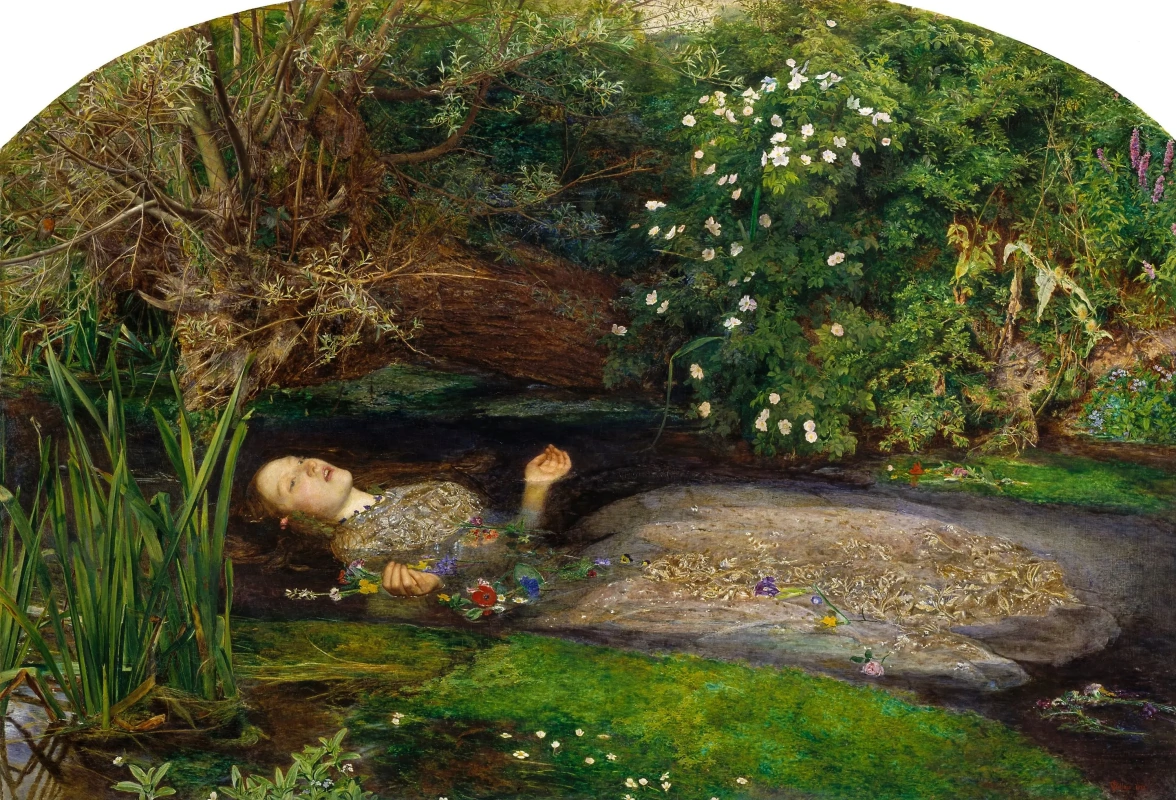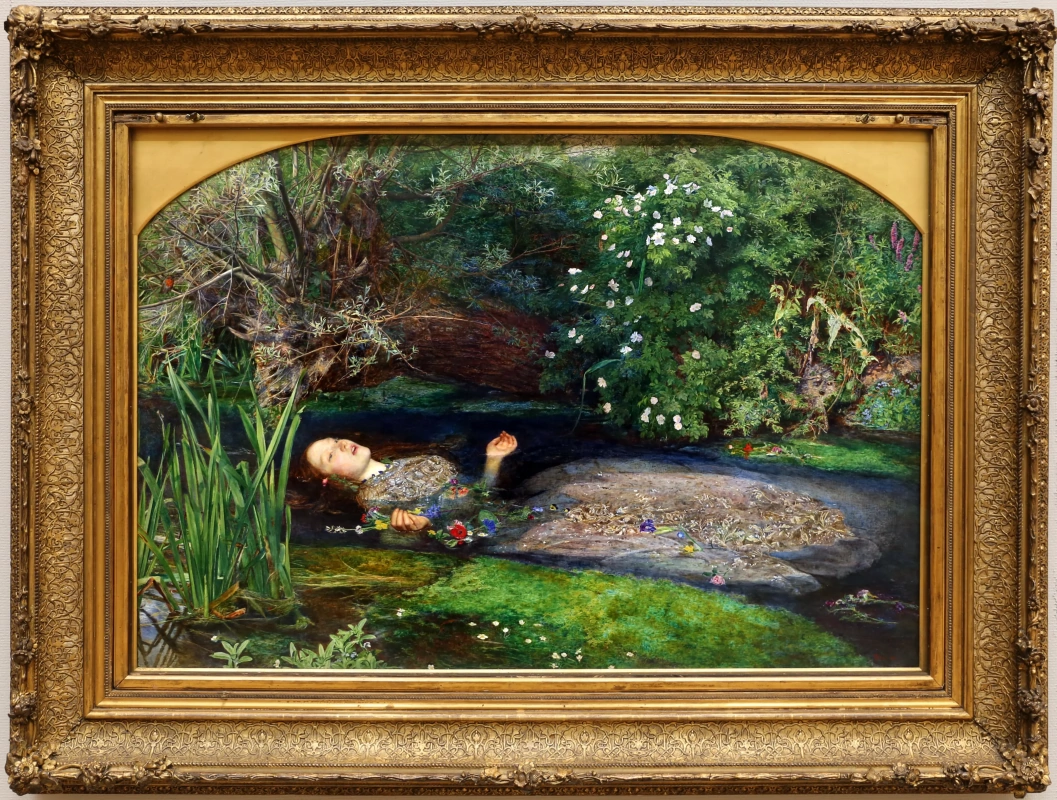log in
Enter site
Login to use Arthive functionality to the maximum
Ophelia
John Everett Millais • Painting, 1852, 76.2×111.8 cm


















Description of the artwork «Ophelia»
Today, at the Tate Gallery's gift shop, where the painting is kept, Ophelia's image on postcards is the most popular purchase among tourists. A person who has never heard of the Pre-Raphaelites and the author of the painting itself must have seen Ophelia somewhere. John Everett Millais was 19 years old when he Dante Gabriel Rosseti and Holman Hunt founded the Pre-Raphaelite Brotherhood, and 22 years old when he wrote Ophelia.
5 months in a row, every day, while it was light, Millet came to the bank of the Hogsmill River and painted the landscape - it was decided to start with it. The summer passed, flies raged and interfered with work, the days became shorter, some flowers bloomed and others bloomed. By November, it had become so cold that the artist had to put together something like a hut thatched with straw - and shelter there from the wind. Buttercups, poppies, forget-me-nots, chamomiles, cornflowers, nettles, camelvines, pansies, violets, weeping willows, irises - it was so important to convey with scientific accuracy the slightest nuances of green shades, the structure of the flower and leaves, the characteristics of each species.
Son Millet wrote that a London-based botanist, instead of going out of town, led students to Ophelia to study plants that were so generously and precisely written on the banks of Hogsmill.
This accuracy of study and the meticulousness of the performance, which made such an incredible favor to the London botanists, was the main principle for the Pre-Raphaelite Brotherhood and Millet, as one of its three founders. Moreover, defiant and revolutionary for its time. Because it was impossible to make out in the paintings taken in the 1850s at the exhibitions of the Royal Academy, not only the species of flowers, but even trees. Dull, relatively beautiful, faceless landscapes, covered with dark noble yellowness - on the one hand. Powerful, rich painting Turnerwho wrote and thought with elements, without sorting grass and flowers - on the other. Pre-Raphaelites declare that one must follow nature unquestioningly, without ignoring anything, noticing everything. And ready to devote themselves to being devoured by mosquitoes and to shake from the November wind to cope with this task - no warm studio with a burning hearth will replace this opportunity to peer and study.
By the way, a tube for paint was invented only 10 years ago - and it has not yet gained wide distribution. So on the bank of the river Millet carried with him the paint, packed in a pig bladder. The landscape was completed only in November - and in the center of the canvas remained an approximate silhouette of Ophelia herself, which was still only imaginary.
Needless to say, pre-Raphaelite artists not only wrote the nature of the British river coasts, without distorting and not losing sight of the smallest details - in the depiction of a man they also abandoned conventionality. Posing must necessarily model. In this quest for accuracy, they reached the point that they chose the size of the canvases so as to transmit objects in full size. It was unlikely that even the most eminent and wealthy artist could find a model that would agree to lie motionless in an icy November creek. What to say about the recent graduate of the Academy of Art. Elizabeth Siddal, a former hat store saleswoman, and now the favorite Pre-Raphaelite muse, has agreed to pose in the bath. So that the girl did not freeze during the session, oil lamps were installed under the bath - this allowed keeping the water at least a little warm.
Once Millet got so carried away that he didn’t notice how the lamps went out - Elizabeth caught pneumonia and almost died, and the artist then received a request from the girl’s father to pay all medical bills. Fortunately, he had money - Ophelia was immediately bought by art dealer Henry Farrell after the exhibition at the Academy of Arts.
Hamlet’s unhappy sweetheart, distraught by grief and committing suicide, will now appear more often than that. No one before Millet wrote it at this terrible moment - a second before dying, taking the last breath. When the picture participated in the big Mille exhibition in Japan, the curators did not choose Ophelia for promotional materials and posters - they were afraid that her enchanting beauty and power would cause suicide among young girls.
Author: Anna Sidelnikova
5 months in a row, every day, while it was light, Millet came to the bank of the Hogsmill River and painted the landscape - it was decided to start with it. The summer passed, flies raged and interfered with work, the days became shorter, some flowers bloomed and others bloomed. By November, it had become so cold that the artist had to put together something like a hut thatched with straw - and shelter there from the wind. Buttercups, poppies, forget-me-nots, chamomiles, cornflowers, nettles, camelvines, pansies, violets, weeping willows, irises - it was so important to convey with scientific accuracy the slightest nuances of green shades, the structure of the flower and leaves, the characteristics of each species.
Son Millet wrote that a London-based botanist, instead of going out of town, led students to Ophelia to study plants that were so generously and precisely written on the banks of Hogsmill.
This accuracy of study and the meticulousness of the performance, which made such an incredible favor to the London botanists, was the main principle for the Pre-Raphaelite Brotherhood and Millet, as one of its three founders. Moreover, defiant and revolutionary for its time. Because it was impossible to make out in the paintings taken in the 1850s at the exhibitions of the Royal Academy, not only the species of flowers, but even trees. Dull, relatively beautiful, faceless landscapes, covered with dark noble yellowness - on the one hand. Powerful, rich painting Turnerwho wrote and thought with elements, without sorting grass and flowers - on the other. Pre-Raphaelites declare that one must follow nature unquestioningly, without ignoring anything, noticing everything. And ready to devote themselves to being devoured by mosquitoes and to shake from the November wind to cope with this task - no warm studio with a burning hearth will replace this opportunity to peer and study.
By the way, a tube for paint was invented only 10 years ago - and it has not yet gained wide distribution. So on the bank of the river Millet carried with him the paint, packed in a pig bladder. The landscape was completed only in November - and in the center of the canvas remained an approximate silhouette of Ophelia herself, which was still only imaginary.
Needless to say, pre-Raphaelite artists not only wrote the nature of the British river coasts, without distorting and not losing sight of the smallest details - in the depiction of a man they also abandoned conventionality. Posing must necessarily model. In this quest for accuracy, they reached the point that they chose the size of the canvases so as to transmit objects in full size. It was unlikely that even the most eminent and wealthy artist could find a model that would agree to lie motionless in an icy November creek. What to say about the recent graduate of the Academy of Art. Elizabeth Siddal, a former hat store saleswoman, and now the favorite Pre-Raphaelite muse, has agreed to pose in the bath. So that the girl did not freeze during the session, oil lamps were installed under the bath - this allowed keeping the water at least a little warm.
Once Millet got so carried away that he didn’t notice how the lamps went out - Elizabeth caught pneumonia and almost died, and the artist then received a request from the girl’s father to pay all medical bills. Fortunately, he had money - Ophelia was immediately bought by art dealer Henry Farrell after the exhibition at the Academy of Arts.
Hamlet’s unhappy sweetheart, distraught by grief and committing suicide, will now appear more often than that. No one before Millet wrote it at this terrible moment - a second before dying, taking the last breath. When the picture participated in the big Mille exhibition in Japan, the curators did not choose Ophelia for promotional materials and posters - they were afraid that her enchanting beauty and power would cause suicide among young girls.
Author: Anna Sidelnikova
Publications about the artwork
Recommended artworks:















